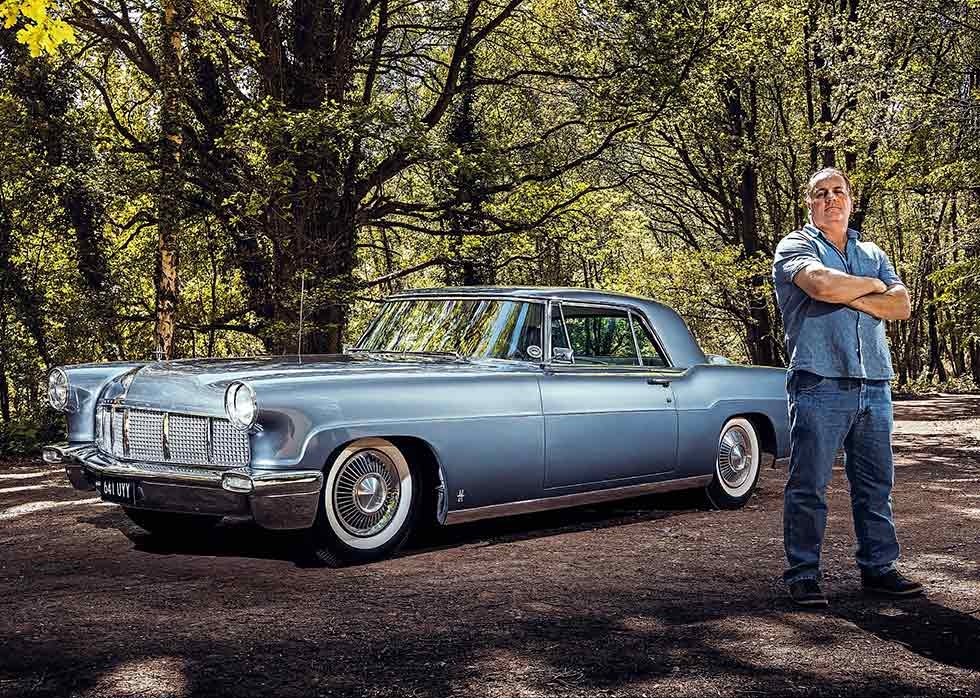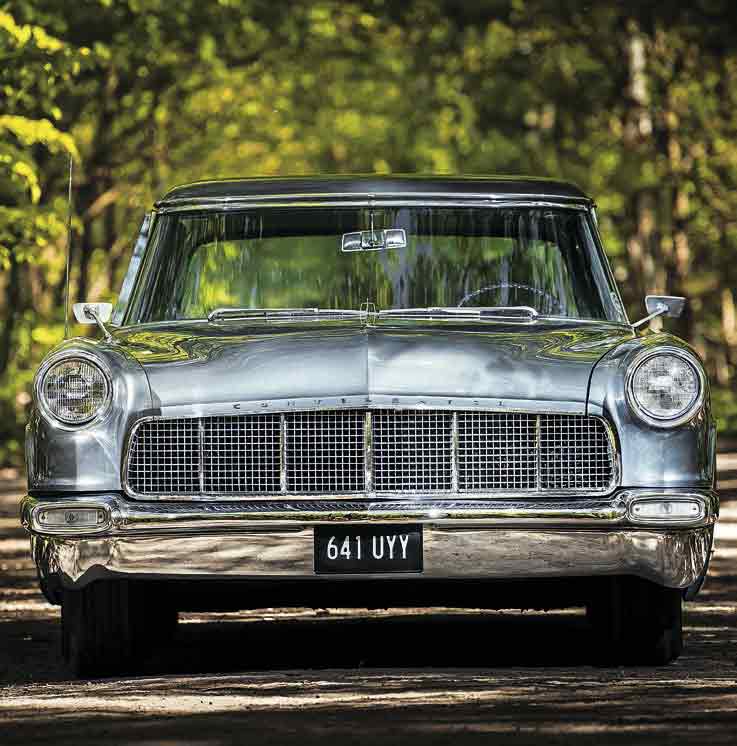
1956 Continental Mark II America’s fines luxury car. Cadillac’s slogan ‘the Standard of the World’ annoyed rivals including the Ford Motor Company, whose response – the Continental Mark II – raised the bar for both the price and quality American cars could achieve. Photography: Jonathan Fleetwood. Words: Nigel Boothman.
A new standard
“I’ve been looking for a car like this for 10 years,” says Terry Jeeves. “There aren’t that many out there, of course, and even fewer good ones.” Terry has owned this beautiful and largely original example since August 2017, when he acquired it from a man in Canada who in turn had rescued it from 29 years in a museum. Does it strike you as odd that someone would be so patient in tracking down a relatively obscure old American car? That probably depends what you know about the Continental Mark II.

We take it for granted that Classic American readers know quite a lot, especially about Mustangs, Tri-Chevys, ’1959 Cadillacs, Corvettes and muscle cars, plus the gist of the Edsel story… but what about the Continental Mark II? My suspicion is that our readers fall into two camps: a few of you have admired them for ages and could recite the story in your sleep; for most they’re a bit of a blind spot. So with apologies to those in the know, we’re going to fill in the blanks.
The Continental Mark II is a revival of an exotic and desirable model that made a big splash just as the Second World War broke out. Edsel Ford, Henry’s only son, asked a gifted stylist called Bob Gregoire to come up with something that echoed the elegant two-door drophead coupes he’d seen in Europe. Within an hour, Gregoire came up with a sketch.
At this point the new car was only going to be a plaything for the boss; a one-off to enjoy during his winters in Palm Beach. But such was the reaction from anyone who saw it that a second car was ordered as a proper prototype, with an eye on production. The list price was $1000 beyond that of the next-most expensive Lincoln, confirming an exclusivity that the car’s looks already suggested. The first production car went to Hollywood actor Jackie Cooper and before long, Babe Ruth, Randolph Scott, Rita Hayworth and Mickey Rooney all had one of these graceful new Lincolns. The name? Continental.
As a brand, it worked perfectly. Americans somehow knew without being told that the continent it referred to was not their own, but mainland Europe, with all its associations of culture, style and sophistication. The original Continental lasted until the end of 1948, when Lincoln launched its first properly new postwar cars, sharing bodies with Mercury. With a bit of hindsight this was always going to concede ground to Cadillac at the top of the pecking order. Their slogan, ‘The Standard of the World’, seemed to bite Ford bosses particularly hard and they decided to fight back with the creation of an entirely new car, sold by a new division.
William Clay Ford, Edsel’s son, led the team behind the project. Edsel had died in 1943 from stomach cancer, aged only 49, and it’s tempting to think that William Ford had a special interest in seeing that the new Continental would live up to his father’s standards. The team set up at the Allen Park Body and Assembly plant outside Detroit, and in 1955 Ford Motor Company established Continental as a separate division. This only contributed to the growing buzz about the new luxury car. Walt Woron, writing in the May 1955 issue of Motor Trend, remarked: “Never can I recall so much interest abounding in the release of a single new automobile…”
Distinctive design
The new car was designed and developed by a group led by chief stylist John Reinhart, chief body engineer Gordon Buehrig (who had designed the Cord 810) and the chief engineer, Harley Copp. As the public would soon discover, the Continental Mark II was created with little emphasis on year-by- year styling fashion, but rather with efforts to mix timeless grace with unmistakable cues from the first Continental.
But the first members of the public to see a car like the one on these pages were not American, but French. To help project an air of imported European luxury, Continental launched the Mark II at the 1955 Paris Motor Show. It was just the spectacular glamour-fest you’d expect, with cars from Facel Vega, Ferrari, Pegaso, Maserati and coachbuilders such as Pininfarina, Boano and Ghia. Citroën’s revolutionary new DS took most of the headlines and there was that spectacular fin-laden Cadillac dream car, the Eldorado Brougham – not yet suggested as a production model. Had Continental’s plan backfired? Was it just a little too sober and sensible to stand out in such a crowd?
The reaction following the car’s domestic launch a few weeks later seemed to confirm the new division’s worst fears. On October 10, 1955, Time magazine reported that 2100 pre-production orders had been taken, but when the cars reached the showrooms many people asked for their deposits back. For the first 10 months of 1956, only 1338 Mark IIs were registered.
It meant the cancellation of plans to expand the Mark II into a three-model range, with a convertible and a four-door sedan due to join the line-up. Production of the coupe continued only until mid-1957 when output for the two model years totalled either 3000 precisely, or just a few more, depending on which source you trust.
The verdict? Motor Trend suggested in 1957 that the car’s styling was seen as too old fashioned, which seems extraordinary now – can you think of another American car from 1955 that could have passed as a production model in 1965? The truth is probably straightforward: most people who wanted to spend that much on a new car felt the Continental should show off its $10,000 price tag rather more obviously than it did.
If this tale leaves you feeling a sense of injustice, we sympathise. William Clay Ford and his team tried something relatively rare in the auto industry at the time – good taste and restraint. They ensured it was done with the highest possible quality control, introducing seven initiatives that involved everyone from top-management to the gate security guards in the process. They were even prepared to lose money on the first year or two of production, and they did – around $1000 per car, but it just wasn’t to be.
Those who did buy the cars obviously cherished them, having spent the price of five Ford Customlines, and more. This meant most survived long enough to become appreciated as classics, although their rise in value has been more recent. Terry Jeeves had to watch them go up and up until last year when he found his.
“I saw it on eBay and eventually sent an assessor to have a look,” he says. “He gave me an appraisal and a valuation that was more than the sum I was going to pay, telling me it was a really good one. For the $600 it cost me, I would recommend an appraisal to anyone who’s serious about buying a valuable car overseas, it was well worth it.”
Terry and his brother Les, also an American car nut, went to collect the Continental from the dock and it was every bit as good as the assessor indicated. “It was repainted once in 1986,” says Terry, “but the interior is 100%original. It’s car number 1710 of the 3000 they made and there’s a gold-plated plaque on the transmission tunnel with the name of the first owner, Loyal W Jodar, MD. He was a plastic surgeon!”
Amazing grace
Well, it took serious money to own one. Dr Jodar chose Deep Gray Opal for his car and it’s a colour that suits the Continental’s semi-formal grace very well. Terry says that the car would have been valued at $20,000 more had it been black, according to the assessor; however, Terry prefers the grey colour to black and it’s really his opinion that matters though, because there’s something we haven’t told you about him.
Terry grew up with American cars and has owned and driven more than we could easily count. He now has a collection of mostly convertibles classics built between 1940 and 1970 that’s entered double figures. He has a Cadillac of exactly the era Lincoln were trying to beat, so he’s in a unique position to give us an informed view of how this car compares. “It cruises very nicely at 60-70mph and feels really steady and solid, especially since I’ve changed the cross-plies for radials. It doesn’t pitch or wallow, but if I was forced to choose, I’d say the Continental drives better. But I have to make allowances for the Cadillac being a convertible – as a coupe, the Lincoln is very quiet and relaxed.”
One more question – among all those other classics (including a wild 1960 Lincoln Continental convertible, and a 1940 Ford coupe), what is it that appealed about the understated Mark II? “It’s the shape. It really bit me… cars are like a disease for me, and I’ve wanted one of these for a very long time. When it’s parked now I still find myself looking at it and thinking ‘yes, I’ve finally done it, I’ve bought the right one this time’.”
The truth is that the Continental Mark II represents the very best of the American motor industry during its golden age – these huge, vastly wealthy firms could afford to invest immense sums in brave new models, and they did. The fact that they sometimes came unstuck and had to admit defeat shows just how large the risks were, but when the end product itself is so blameless – as is the case with the Mark II – we can only be grateful that they were allowed to try. What was one of the best cars of its day is now one of the most impressive classic cars to grace our scene. It’s never too late for a bit of recognition, is it?
CONTINENTAL: THE ORIGIN STORY
Just as Americans knew which continent the 1940 Lincoln-Zephyr Continental was referring to, wealthy Britons assumed the same thing when considering a Rolls-Royce Phantom II Continental as far back as 1930.
The story is remarkably similar to that of Edsel Ford and Bob Gregoire, only in this instance Sir Henry Royce asked designer Ivan Evernden to build him a one-off, short wheelbase Phantom II. It had a tuned engine, stiffer springs and a lightweight body, making it ideal for fast touring on long continental roads, but – here’s the crucial difference – with the owner at the wheel and the chauffeur left at home. Rolls-Royce built 281 Phantom II Continentals, many bodied by outside coachbuilders in two-door sedanca de ville or drophead coupe styles – long bonnets, a short rear deck, low overall roofline and often one or two spare wheels mounted aft of the trunk on the tail.
Edsel Ford’s inspiration is therefore pretty clear, even if Bob Gregoire’s brilliantly executed styling job was entirely his own. Still, it’s odd to think when looking at this lovely Continental Mark II that it’s inherited many of its basic styling features from English firms such as Gurney-Nutting, Barker and H J Mulliner.
And its name, of course, was a straight lift, which Rolls-Royce took back again in 1952 for the Bentley R-Type Continental. Since then, Bentley and Lincoln have shared the name over many decades as it’s passed in and out of use. Currently, both firms are making a Continental… neither of which owes much to these classic early models.
Fixed-head coupe on 1933 Phantom II. Two-door fixed-head coupe on 1930 Phantom II. The perfect gift for the man who has everything. Lincoln Continental. William Clay Fordwith1956 Lincoln Continental Mark II.
Photos
“WHAT WAS ONE OF THE BEST CARS OF ITS DAY IS NOW ONE OF THE MOST IMPRESSIVE CLASSICS.”
Most of the original Continentals were convertibles, but for the Mark II, only the coupe made it to production. A couple of factory convertibles were built as prototypes, together with 18 others converted by a coachbuilder in period. These can now command $200,000. The 368cu in V8 was rated at 300hp and turned a Turbo-Drive three-speed automatic transmission. The driveline was one of the few aspects of the car shared with regular Lincoln models. If you see a Mark II with over-riders on the front bumper, it probably means it started life in a state that required a front number plate. Continental felt that an unframed plate on a plain bumper would look unattractive. The hubcaps are extraordinarily labour-intensive to make or to restore, with one nut for each spoke.
Those T-handle controls are for the heating system. Terry says you need the workshop manual just to figure out how they’re all supposed to work – and this one doesn’t even have the Mark II’s single option, air conditioning, at an extra $595. For such a rare car, parts support is surprisingly good, with reproductions of some very obscure little items such as door lock covers easily available from Mark II Enterprises in California. The rumoured $10,000 price of the new Continental gave Cadillac something to top, and top it they did – by late 1956, when the Continental was already on sale, Cadillac announced the Eldorado Brougham at $13,074. Had they known of the minimal commercial impact the Continental would eventually have, they may never have bothered trying to better it.







